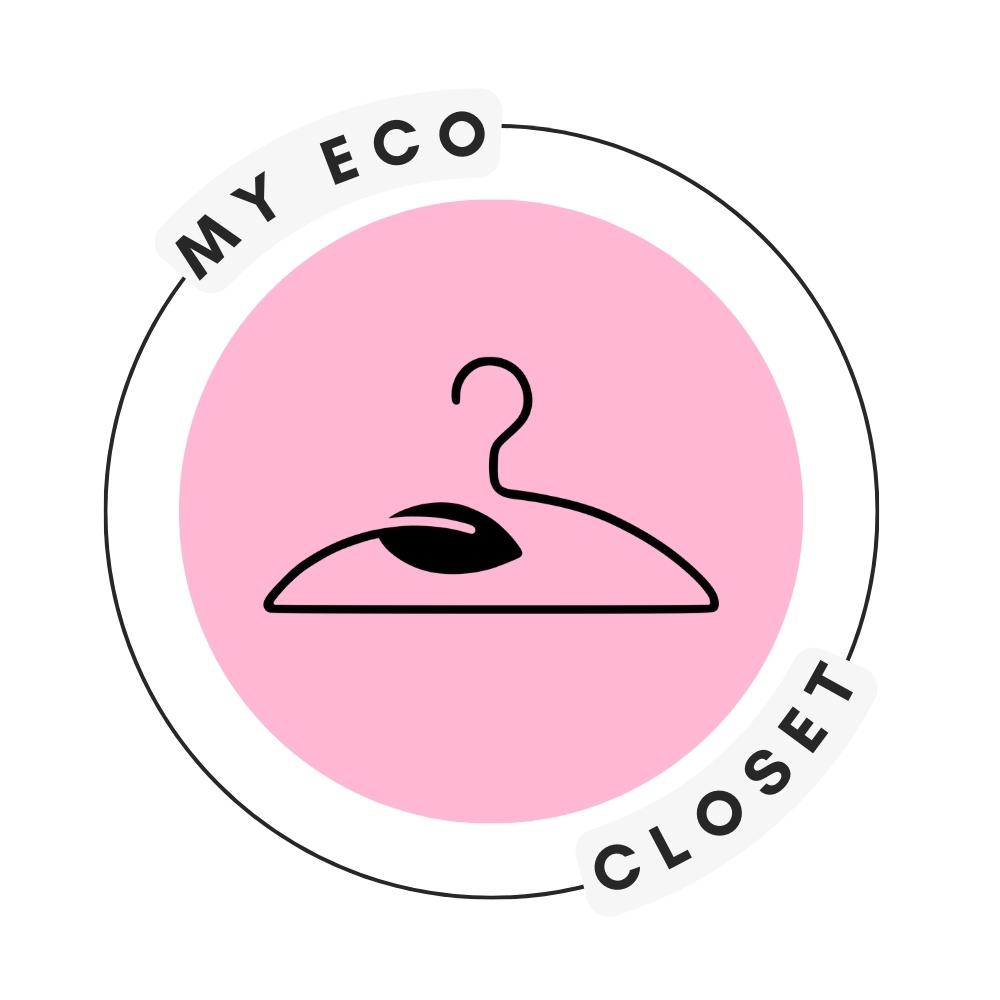Did you know the average person wears only 20% of their wardrobe regularly? I learned this during my journey to a more intentional lifestyle. Back then, I often felt like I had ‘nothing to wear’ despite owning a packed closet. That’s when I asked, “how many clothes do I need as a minimalist?” — a question that transformed my life. Below, I’ll walk you through how to find the right balance and create a minimalist wardrobe that fits you needs.

The Minimalist Blueprint: Small Capsule Wardrobe (10-15 Pieces)
The small capsule wardrobe represents minimalism at its finest. With just 10-15 carefully chosen pieces, this compact collection proves that less truly can be more. Think of it as your desert island wardrobe — if you had to pack just one small suitcase, these would be the pieces you couldn’t live without.
Essential Pieces (12 Core Items):
Tops (5 Total)
- 2 basic t-shirts (white and black)
- 1 button-down shirt
- 1 lightweight sweater
- 1 dressy blouse
Bottoms (3 Total)
- 1 pair of dark wash jeans
- 1 pair of black trousers
- 1 versatile skirt or shorts
Dresses (2 Total)
- 1 casual day dress
- 1 dress-up option
Outerwear (2 Total)
- 1 denim or utility jacket
- 1 lightweight coat or blazer
Footwear (1 Pair)
- 1 pair of versatile sneakers or flats
Making It Work
With this minimal setup, you can create approximately 30 different combinations. The key is choosing pieces in a coordinated color palette where everything matches everything else.
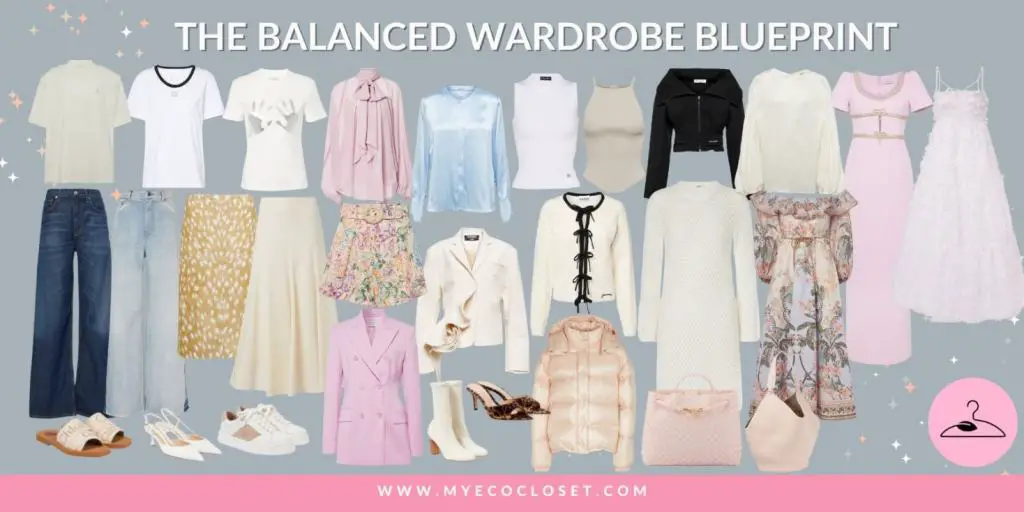
The Balanced Blueprint: Medium Capsule (30-35 Pieces)
The medium capsule wardrobe represents the sweet spot for many people. It gives you enough variety to handle multiple aspects of life while maintaining the benefits of a streamlined closet. This size allows for more seasonal variation and special occasions without overwhelming your space or morning routine.
Essential Pieces (32 Core Items):
Tops (10 Total)
- 3 basic t-shirts
- 2 blouses
- 2 tank tops
- 2 long-sleeve shirts
- 1 statement top
Bottoms (7 Total)
- 2 pairs of jeans (light and dark wash)
- 2 pairs of trousers
- 1 pair of shorts
- 2 skirts (casual and dressy)
Dresses (5 Total)
- 2 casual dresses
- 1 work dress
- 1 cocktail dress
- 1 maxi dress
Outerwear (5 Total)
- 1 blazer
- 1 cardigan
- 1 denim jacket
- 1 winter coat
- 1 rain jacket
Footwear (5 Pairs)
- Everyday sneakers
- Professional flats or heels
- Casual sandals
- Ankle boots
- Dressy shoes
Making It Work
This size allows for about 100 different outfit combinations and handles most lifestyle needs while maintaining organization.
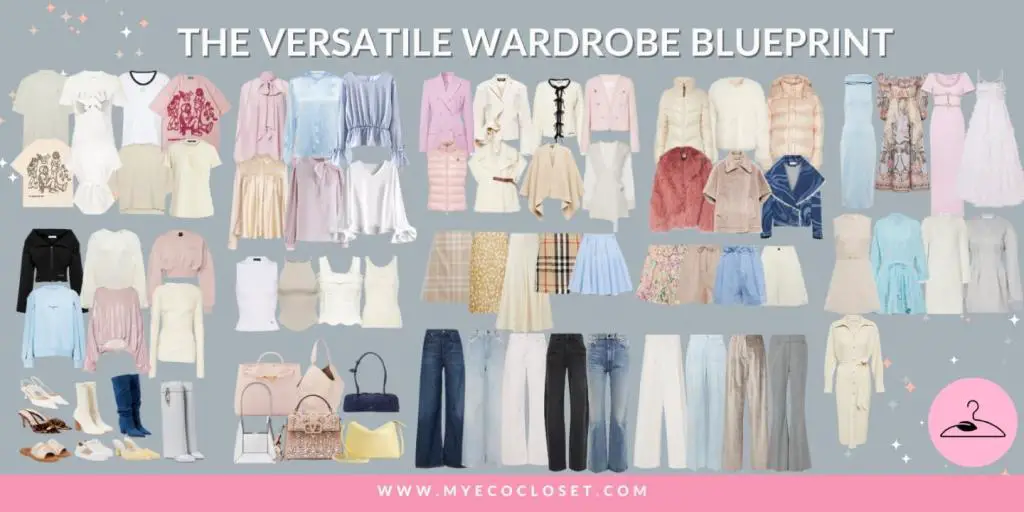
The Versatile Blueprint: Large Capsule (100 Pieces)
The large capsule wardrobe may seem to contradict the minimalist principle, but it can be a thoughtful approach. It allows you to maintain a varied wardrobe without falling into excess. This size works particularly well for people with multiple roles in their lives or those living in areas with extreme seasonal changes.
The versatile blueprint is perfect for:
- Fashion enthusiasts
- Those with varied social/professional needs
- People living in extreme climates
- Anyone transitioning from a traditional wardrobe
Essential Pieces (100 Core Items):
Tops (30 Total)
- 8 t-shirts
- 6 blouses
- 4 tank tops
- 6 long-sleeve shirts
- 6 sweaters/knits
Bottoms (20 Total)
- 5 pairs of jeans
- 5 pairs of trousers
- 5 skirts
- 5 pairs of shorts/casual bottoms
Dresses (15 Total)
- 5 casual dresses
- 5 work dresses
- 5 formal/special occasion dresses
Outerwear (15 Total)
- 3 blazers
- 3 cardigans
- 3 casual jackets
- 3 seasonal coats
- 3 specialty pieces (rain jacket, formal coat, etc.)
Footwear (20 Pairs)
- 5 casual shoes
- 5 professional shoes
- 5 seasonal shoes
- 5 specialty/occasion shoes
Making It Work
This larger capsule can create hundreds of combinations while still maintaining organization and purpose.
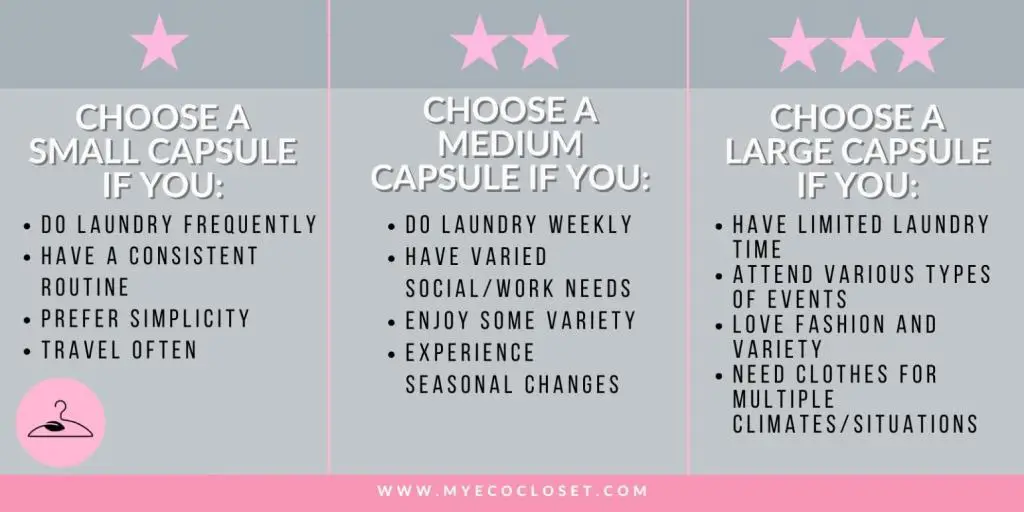
Choosing Your Ideal Blueprint
Ask yourself:
- How often do you do laundry?
- How many different environments do you dress for?
- What’s your tolerance for outfit repetition?
Small Capsule If You:
- Do laundry frequently
- Have a consistent routine
- Prefer simplicity
- Travel often
Medium Capsule If You:
- Do laundry weekly
- Have varied social/work needs
- Enjoy some variety
- Experience seasonal changes
Large Capsule If You:
- Have limited laundry time
- Attend various types of events
- Love fashion and variety
- Need clothes for multiple climates/situations
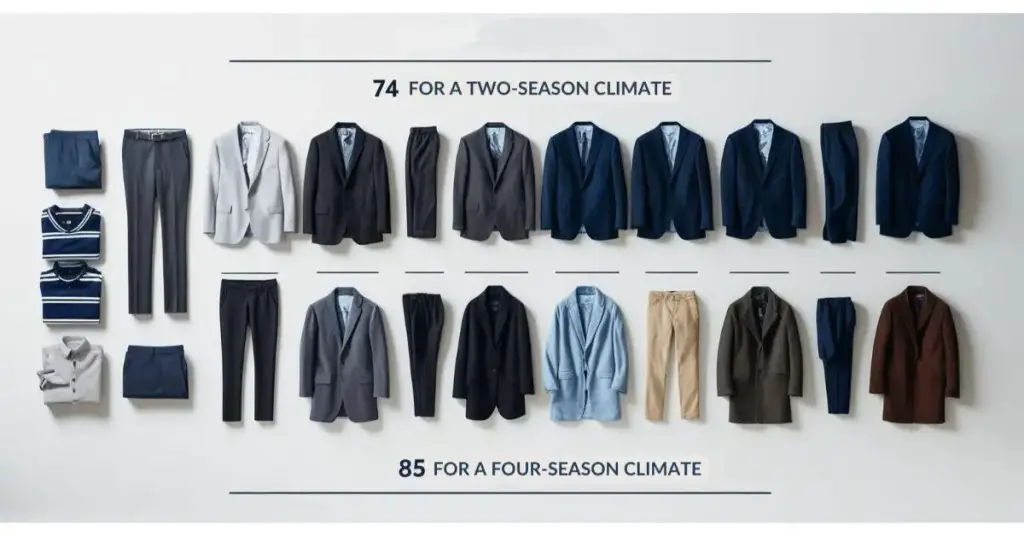
How many clothes do I need, according to research?
According to a report from Berlin’s Hot Or Cool Institute, in areas with two seasons, people should own about 74 garments. Those living in regions with four seasons might want around 85 pieces of clothing. This would cover everything from work clothes to weekend wear, including professional outfits, eveningwear, and jackets for different weather.
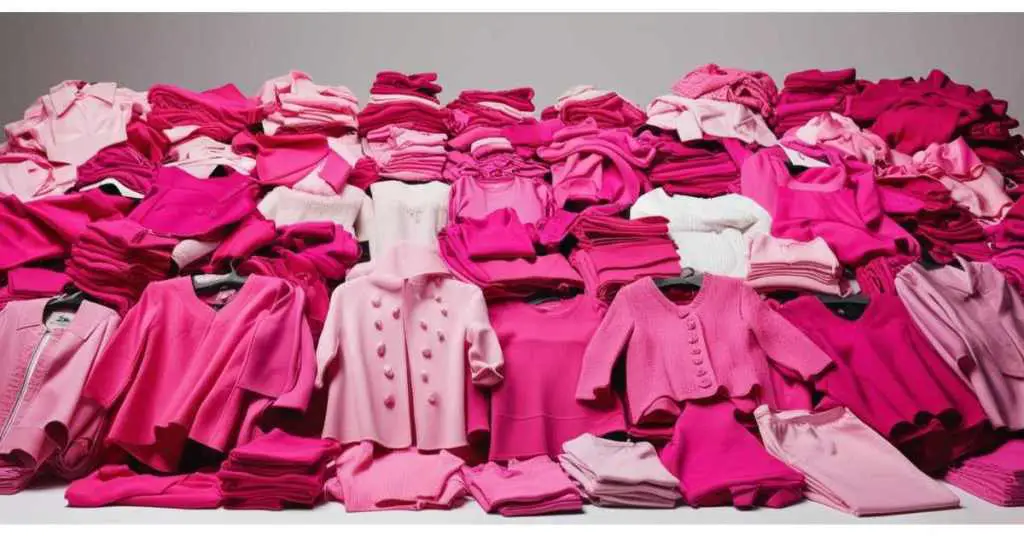
The Overconsumption Problem
Unfortunately, many people buy far more clothes than they actually need or use. Americans purchase an average of 53 new clothing items each year, a number that has grown dramatically since 2000. This massive overconsumption reveals a stark disconnect between what we buy and what we truly wear.
Moreover, research shows that people leave most of their wardrobe untouched. An astonishing 82% of clothing sits unworn throughout the year, and the average garment is used only seven times before being discarded. This pattern of buying and quickly abandoning clothes creates significant environmental and financial waste.
The Real Talk About Capsule Wardrobes
Let’s be honest – minimalist wardrobes aren’t just about picking 30-40 pieces and calling it a day. They require a fundamental shift in how we think about fashion and consumption. Now that we have explained the ‘how,’ let’s address the ‘why’ and whether this lifestyle is truly realistic for you.
The Hard Questions You Need to Ask Yourself:
- Can you resist the siren call of trending pieces for the next few years?
- Do you find joy in creating new combinations with existing pieces?
- Are you willing to invest time in understanding your personal style rather than copying influencers?
If you hesitated on any of these questions, that’s okay! Understanding these challenges is the first step toward making the right choices.

Overcoming Psychological Obstacles
Beyond asking yourself, “how many clothes do I need as a minimalist?”, it’s crucial to examine what drives your consumption habits. The psychological pressures of consumerism can often get in the way of building and maintaining a minimalist wardrobe. By understanding these influences, you can make more intentional choices. Given that, here are a few common hurdles and how to overcome them:
1. Fear of Missing Out (FOMO)
It’s easy to feel like you’re missing out if you’re not constantly updating your wardrobe with the latest trends. Social media often magnifies this pressure, leading us to believe that new clothes are the key to staying relevant.
How to Overcome It: Avoid the trap of comparison by doing a digital detox or following sustainable fashion influencers. Focus on your personal style and resist the urge to buy because others are. Remember, minimalist fashion is about curating what works for you, not keeping up with everyone else.
2. Desire for Social Validation
Fashion is often used to show social status. Receiving compliments or likes online exacerbates the urge for validation through clothing. In a world that values materialism and appearance, the temptation to buy for approval, rather than personal satisfaction, is constant.
How to Overcome It: Minimalism encourages you to define your style for yourself, not for external approval. Ask yourself, “Do I love this piece?” rather than, “Will others like it?” When you build a wardrobe that feels true to you, it’s easier to resist the pull of validation through consumption.
3. Emotional Attachments to Clothes
Many of us hold onto clothes because they represent memories, milestones, or a particular identity we once identified with. Whether it’s a dress from a trip, or a jacket from a past phase, these attachments can make it difficult to let go, even when the clothes no longer serve us.
How to Overcome It: Minimalism isn’t about eliminating everything, but about keeping what truly serves you. Let go of items that no longer reflect who you are or your lifestyle. This process can create space for new experiences and a wardrobe that truly fits your present self.

Year-Round Capsule Wardrobe: A Seasonless Approach
Building a minimalist wardrobe isn’t about ruthlessly cutting clothes, but about creating a versatile collection that serves you year-round. Imagine clothing that moves seamlessly between contexts and temperatures — a blazer that’s equally powerful in a boardroom or at a cocktail party, a little black dress that transforms from day to night with a simple accessory change.
Using a checklist for determining “how many clothes do I need” can help you select pieces that truly serve your year-round needs.
Choosing Seasonless Materials
When building a year-round wardrobe, temperature-regulating materials are your secret weapon. Wool, silk, and organic cotton let your clothes breathe with you. They keep you comfortable when layering in winter and provide lightweight comfort in summer. Wool, in particular, contains natural crimp in its fibers, creating tiny air pockets. This allows the fabric to keep you warm when cold and vice-versa.
Seasonless Silhouettes
Seasonless clothing also relies on adaptable silhouettes. These designs are neither too tight nor too loose, and they allow you to layer easily. Take a midi skirt: it’s the perfect length for winter with tights or for summer with sandals.
Similarly, a classic button-down shirt or tailored pants can be worn on their own in warmer months. Alternatively, they can be layered with sweaters and jackets when it’s cooler. The goal isn’t just owning fewer clothes. It’s choosing pieces that adjust to the seasons, offering style and comfort no matter the weather.
Frequently Asked Questions
A minimalist wardrobe can range from 10-15 pieces (Small Capsule) to 30-35 pieces (Medium Capsule) or 100 pieces (Large Capsule), depending on your lifestyle, needs, and how much variety you prefer. The key is selecting versatile, high-quality items that serve multiple purposes and align with your daily routine.
Yes, a well-curated capsule wardrobe can work for all seasons. The key is choosing versatile, seasonless fabrics like wool, silk, and organic cotton, which offer breathability and warmth. With adaptable silhouettes, you can layer pieces in colder months or wear them on their own in warmer weather, ensuring year-round comfort and style.
To resist buying unnecessary clothes, focus on quality over quantity. Ask yourself if the piece adds value to your wardrobe or if it’s just a trend. Reducing exposure to fast fashion, following sustainable fashion influencers, and practicing mindful shopping can help curb impulsive purchases and reinforce your minimalist approach.
Emotional attachments to clothes are common, but minimalism isn’t about eliminating everything. Keep items that truly reflect your current life and personal style. For clothes tied to memories, consider donating or repurposing them rather than keeping them if they no longer fit your lifestyle or wardrobe goals.
Studies show that the average person only wears 20% of their wardrobe regularly. The remaining 80% often sits unused, leading to overconsumption and unnecessary clutter. A minimalist wardrobe helps you focus on the clothes you truly love and wear, reducing waste and simplifying your clothing choices.
Minimalist fashion is ideal for those who value simplicity, durability, and intentionality in their wardrobe. It works best for people who want to reduce clutter, make fewer but more meaningful purchases, and focus on building a wardrobe that aligns with their true style and needs, rather than chasing trends.
